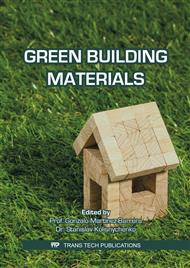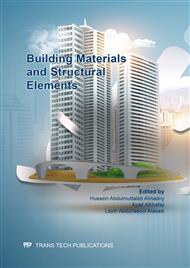[1]
P.J. Cosentino and H.H. Howell, Developing re-use applications and improving the economic benefits of Florida's waste materials. 2006, Florida Center for Solid and Hazardous Waste Management: USA.
Google Scholar
[2]
S.A. Frondistou and T. Itoh, Economic feasibility of concrete recycling. Journal of the Structural Division, 1977. 103(4): pp.885-899.
DOI: 10.1061/jsdeag.0004613
Google Scholar
[3]
S.A. Chini, T.J. Sergenian and J. Marmaghani, Use of recycled aggregates for pavement. In: Materials for the new millennium. 2001: Washington, USA.
Google Scholar
[4]
S. Jayakody, C. Gallage, and A. Kumar, Assessment of recycled concrete aggregates for road base and sub-base. The 2nd International Conference on Geotechnique, Construction Materials and Environment. 2012: Kuala Lumpur, Malaysia.
Google Scholar
[5]
J.R. Jiménez, F. Agrela, J. Ayuso, and M. López, A comparative study of recycled aggregates from concrete and mixed debris as material for unbound road sub-base. Material Construction, 2011. 61(302): pp.289-302.
DOI: 10.3989/mc.2010.54009
Google Scholar
[6]
T.D. Kelly, The substitution of crushed cement concrete for construction aggregates. Geological Survey Circular 1177. 1998, USA.
Google Scholar
[7]
B. Prowell, G.E. Hurley and B. Frank, Warm-Mix Asphalt: Best Practices. Second edition. 2011, Lanham, MD, USA: National Asphalt Pavement Association (NAPA).
Google Scholar
[8]
S. Rakshvir and S.V. Barai, Studies on Recycled aggregates bases concrete. Waste Management Research, 2006. 24(3): pp.225-233.
DOI: 10.1177/0734242x06064820
Google Scholar
[9]
S. Daquan, T. Yang, G. Sun, P. Qi, Y. Fan, and Z. Xingyi, Performance evaluation of asphalt mixtures containing recycled concrete aggregates. International Journal of Pavement Engineering, 2018. 19(5): pp.422-428.
DOI: 10.1080/10298436.2017.1402594
Google Scholar
[10]
Y. Hou, X. Ji, J. Li and X. Li, Adhesion between asphalt and recycled concrete aggregate and its impact on the properties of asphalt mixture. Journal of Materials, 2018. 11: pp.25-28.
DOI: 10.3390/ma11122528
Google Scholar
[11]
C.H. Lee, J.C. Du and D.H. Shen, Evaluation of pre-coated recycled concrete aggregate for hot mix asphalt. Construction and Building Materials, 2012. 28: pp.66-71.
DOI: 10.1016/j.conbuildmat.2011.08.025
Google Scholar
[12]
I. Pérez, J. Gallego, M. Toledano, and J. Taibo, Asphalt mixtures with construction and demolition debris. Proceedings of the Institution of Civil Engineers - Transport, 2010. 163(4): pp.1-9.
DOI: 10.1680/tran.2010.163.4.165
Google Scholar
[13]
Z.Y. Pan, G. Li, C.Y. Hong, H.L. Kuang, Y. Yu, F.X. Feng, D.M. Liu, and H. Du, Modified recycled concrete aggregates for asphalt mixture using microbial calcite precipitation. Journal of the Royal Society of Chemistry (RSC) Advances, 2015. 5(44): p.34854–34863.
DOI: 10.1039/c5ra04203h
Google Scholar
[14]
M.M. Rafi, A. Qadir and S.H. Siddiqui, Experimental testing of hot mix asphalt mixture made of recycled aggregates. Waste Management Research, 2011. 29(12): pp.1316-1326.
DOI: 10.1177/0734242x10370379
Google Scholar
[15]
A.R. Pasandín and I. Pérez, Performance of hot-mix asphalt involving recycled concrete aggregates. International Journal of Pavement Engineering, 2020. 21(9): pp.1044-1056.
DOI: 10.1080/10298436.2018.1518525
Google Scholar
[16]
S. Bhusal, X. Li and H. Wen, Evaluation of Effects of Recycled Concrete Aggregate on Volumetrics of Hot-Mix Asphalt. 2011. 2205(1): pp.36-39.
DOI: 10.3141/2205-05
Google Scholar
[17]
A.R. Pasandín and I. Pérez, Mechanical properties of hot-mix asphalt made with recycled concrete aggregates coated with bitumen emulsion. Construction and Building Materials, 2014. 55: p.350–358.
DOI: 10.1016/j.conbuildmat.2014.01.053
Google Scholar
[18]
J. Qiu, D.Q.S. Tng and E.H. Yang, Surface treatment of recycled concrete aggregates through microbial carbonate precipitation. Construction and Building Materials, 2014. 57: pp.144-150.
DOI: 10.1016/j.conbuildmat.2014.01.085
Google Scholar
[19]
Asphalt Institute, Mix design methods for asphalt concrete and other hot-mix types. MS-2. (1997).
Google Scholar
[20]
Ministry of Construction and Housing, General specification for roads and bridges (SORB/R9). 2003: Iraq.
Google Scholar
[21]
ASTM D5/D5M-20, Standard test method for penetration of bituminous materials, ASTM International, West Conshohocken, PA, 2021, www.astm.org.
Google Scholar
[22]
ASTM D88/D88M e1, Standard test method for saybolt viscosity, ASTM International, West Conshohocken, PA, 2021, www.astm.org.
Google Scholar
[23]
ASTM D113-17, Standard test method for ductility of asphalt materials, ASTM International, West Conshohocken, PA, 2021, www.astm.org.
Google Scholar
[24]
ASTM D36/D36M-14(2020), Standard test method for softening point of bitumen (Ring and Ball Apparatus), ASTM International, West Conshohocken, PA, 2021, www.astm.org.
Google Scholar
[25]
ASTM D70/D70M-21, Standard test method for specific gravity and density of semi-solid asphalt binder (Pycnometer Method), ASTM International, West Conshohocken, PA, 2021, www.astm.org.
DOI: 10.1520/d0070-18a
Google Scholar
[26]
ASTM D92-18, Standard test method for flash and fire points by Cleveland open cup tester, ASTM International, West Conshohocken, PA, 2021, www.astm.org.
DOI: 10.1520/d8254
Google Scholar
[27]
ASTM C117-17, Standard test method for materials finer than 75-μm (No. 200) sieve in mineral aggregates by washing, ASTM International, West Conshohocken, PA, 2021, www.astm.org.
DOI: 10.1520/c0117
Google Scholar
[28]
ASTM D6926-20, Standard practice for preparation of asphalt mixture specimens using Marshall apparatus, ASTM International, West Conshohocken, PA, 2021, www.astm.org.
Google Scholar
[29]
ASTM D6927-15, Standard test method for Marshall stability and flow of asphalt mixtures, ASTM International, West Conshohocken, PA, 2021, www.astm.org.
Google Scholar
[30]
ASTM D1075-11, Standard test method for the effect of water on compressive strength of compacted bituminous mixtures, ASTM International, West Conshohocken, PA, 2021, www.astm.org.
Google Scholar
[31]
B.J. Al-Saeedi and H.A. Al-Jameel, Sustainable Performance of Iraqi Asphalt Base Course Using Recycled Glass as Aggregate Replacement. Journal of University of Babylon, 2018. 26(5): pp.63-80.
DOI: 10.29196/jub.v26i5.869
Google Scholar
[32]
M. Arabani, Effect of glass cullet on the improvement of the dynamic behavior of asphalt concrete. Construction and Building Materials, 2011. 25(3): pp.1181-1185.
DOI: 10.1016/j.conbuildmat.2010.09.043
Google Scholar



